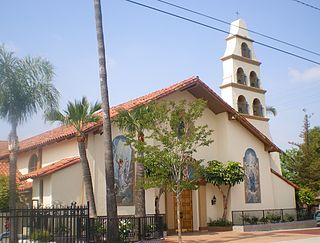
San Fernando is a general-law city in the San Fernando Valley region of Los Angeles County, California, in the Los Angeles metropolitan area. It is an enclave in the City of Los Angeles. As of the 2020 census the population of San Fernando was 23,946.

The San Fernando Valley, known locally as the Valley, is an urbanized valley in Los Angeles County, California. Situated northwards of the Los Angeles Basin, it comprises a large portion of Los Angeles, the incorporated cities of Burbank, Calabasas, Glendale, Hidden Hills and San Fernando, plus several unincorporated areas. The valley is the home of Warner Bros. Studios, Walt Disney Studios, and the Universal Studios Hollywood theme park.

Sylmar is a suburban neighborhood in the San Fernando Valley and is the northernmost neighborhood within the city of Los Angeles, California, United States. Historically known for its profusion of sylvan olive orchards, Sylmar can trace its past to the 18th century and the founding of the San Fernando Mission. In 1890, olive production was begun systematically. The Sylmar climate was also considered healthy, and so a sanitarium was established, the first in a series of hospitals in the neighborhood. There are fourteen public and eight private schools within Sylmar.
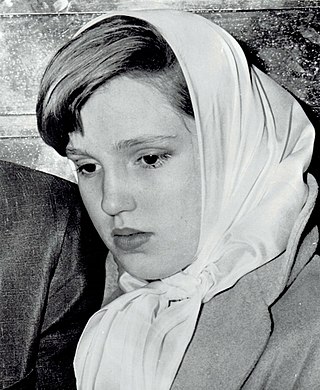
Cheryl Christina Crane is an American former model, retired real estate broker, author, and the only child of actress Lana Turner. Her father was Turner's second husband, actor-turned-restaurateur Steve Crane. She was the subject of significant media attention in 1958 when, at fourteen years old, she stabbed to death her mother's lover, Johnny Stompanato, during a domestic struggle; she was not charged, and his death was deemed a justifiable homicide.

Lake View Terrace is a suburban neighborhood in the San Fernando Valley region of the City of Los Angeles, California.
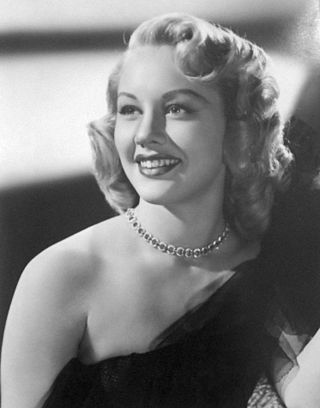
Lila Leeds was an American film actress.

The Harbor Gateway, historically and sometimes informally known as the Shoestring due to its shape, is a 5.14-square-mile residential and industrial area (13.3 km2) in the South Bay and Los Angeles Harbor Region, in the southern part of the City of Los Angeles. The neighborhood is narrow and long, running along a north-south axis.
Winlaton Youth Training Centre was a Government owned and run female youth correctional facility located on 18 acres (73,000 m2) at 186 Springvale Road Nunawading, Victoria, Australia. The facility was designed to accommodate 14- to 18-year-old wards of the state. It opened in 1956 as the Winlaton Juvenile School, and closed in 1993 as the Nunawading Youth Residential Facility. A housing estate now occupies the site.
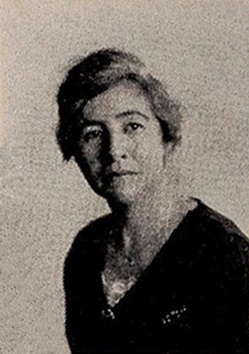
Miriam Van Waters was an American prison reformer of the early to mid-20th century whose methods owed much to her upbringing as an Episcopalian involved in the Social Gospel movement. During her career as a penologist, which spanned most of the years from 1914 through 1957, she served as superintendent of three prisons: Frazier Detention Home for boys and girls in Portland, Oregon; Los Angeles County Juvenile Hall for girls, and the Massachusetts Correctional Institution – Framingham, then called the Massachusetts Reformatory for Women. While in California, Van Waters established an experimental reformatory school, El Retiro, for girls age 14 to 19. In each case, Van Waters developed programs that favored education, work, recreation, and a sense of community over unalloyed incarceration and punishment.
Thomas Jefferson Cuddy, known as T.J. Cuddy, nicknamed Tom, was a 19th-century police chief in Los Angeles, California, until bribery forced resignation, and member of the Los Angeles Common Council, the city's governing body. He served a six-month jail term for contempt of court.

Mack Ray Edwards was an American child molester and serial killer who molested and murdered at least six children in Los Angeles County, California, between 1953 and 1970. Sentenced to death, he hanged himself in his prison cell.

The Los Angeles County Probation Department provides services for those placed on probation within Los Angeles County, California. Guillermo Viera Rosa is the current chief probation officer. The department is the largest probation department in the world.
El Rancho High School is a public high school located in the city of Pico Rivera, California, United States. It is a part of the El Rancho Unified School District.

The Sayre Fire, also known as the Sylmar Fire, was a November 2008 wildfire that resulted in the loss of 489 residences in Los Angeles, California, United States, the "worst loss of homes due to fire" in the city's history. The fire was first reported at 10:29 p.m. PDT on November 14, 2008, in the Sylmar section of Los Angeles. As of November 20, 2008, the fire was 100% contained, had burned 11,262 acres (46 km2) and destroyed more than 600 structures. The number of homes lost in the Sayre fire exceeded the prior record set in 1961 by the Bel Air Fire which claimed 484 homes. There were no fatalities, just minor injuries to five firefighters and one civilian.

Los Angeles's 7th City Council district is one of the fifteen districts in the Los Angeles City Council. It is currently represented by Democrat Monica Rodriguez since 2017 after winning an election to succeed Felipe Fuentes, who resigned the year prior.

Orfa Jean Shontz was an American attorney and Municipal Judge. She was the first female referee of the Juvenile Court of Los Angeles County. She was the first female in California to "sit on the bench and administer justice".

Detour: A Hollywood Story is a 1988 memoir by Cheryl Crane, the only daughter of actress Lana Turner, with additional writing from Cliff Jahr. In the book, she recounts her early life, including her alleged sexual abuse by her stepfather Lex Barker, and the 1958 killing of Johnny Stompanato during a domestic struggle. She also details her coming out as a lesbian to her parents as a teenager, a fact that had not been publicly disclosed prior. The book went on to become a New York Times Best Seller.
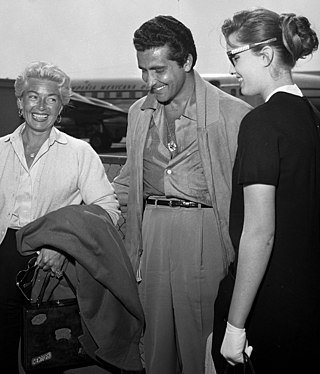
On the evening of April 4, 1958, 14-year-old Cheryl Crane fatally stabbed 32-year-old Johnny Stompanato, the boyfriend of her mother, actress Lana Turner, at Turner's rented home in Beverly Hills, California, United States. Stompanato, a former Marine and an associate of the Cohen crime family, had been in a year-long relationship with Turner that had been rocky and marked with physical abuse.

The Ghanaian juvenile justice system encompasses the processes to handle minors who are in conflict with the law or who are in need of care and protection. The formal Ghanaian juvenile justice system was created under colonial rule and has evolved greatly since the early 1900s. Three stark changes for the system are throughout the colonial period, the beginnings of independence and the 1960 Criminal Procedure Code, and the newest Juvenile Justice Act.

Robert Eugene McKee Sr. (1889–1964) was an American construction contractor and founder of the Robert E. McKee General Contractor, Inc. company.

















